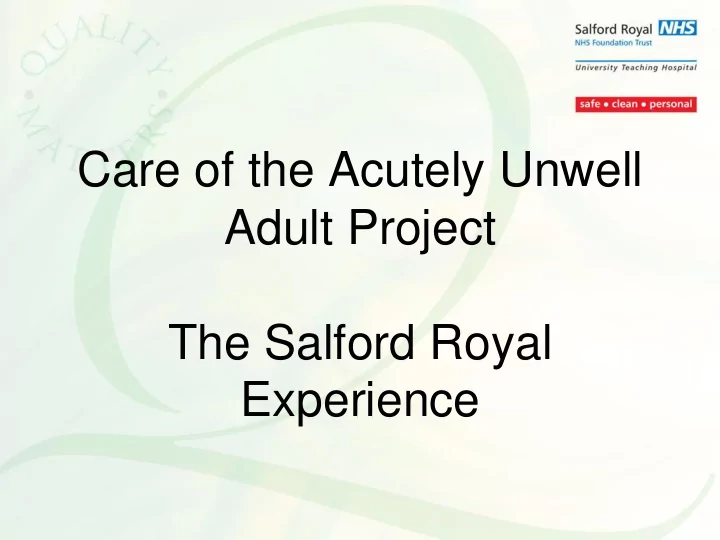

Care of the Acutely Unwell Adult Project The Salford Royal Experience
Do we need a hero?
Why Undertake the Initiative? • Department of Health and other agencies highlighted the complexities of managing acutely unwell patients. • UK organisations were challenged by NICE to work to dramatically improve the quality of services in accordance with evidence based best practice. • Comprehensive Critical Care (DOH, 2000) and the nursing contribution to the provision of comprehensive critical care for adults (DOH, 2001) highlighted the need for critical care services to be available to all patients in hospital, regardless of their location.
Why Undertake the Initiative? • Adverse incident reports prior to start of project: – 29 reported incidents which identified sub optimal care contributing to patient‟s death – A further 100 incidents reported unexpected deterioration • 135 cardiac arrests (outside units) annually with a survival rate of approximately 10 - 15%
Objectives • We set a stretch target to: – Reduce cardiac arrests outside critical care units by 50% by March 2010 • Why? – We knew that a stretch target of 50% would create tension – We wanted to create a burning platform – Emphasise that the status quo was no longer acceptable
50% reduction in arrests in 1 year
The Process Project Structure Model for Improvement Phase 2: Phase 1: Phase 3: 11 wards with Further 11 Changes highest number wards with launched of cardiac highest cardiac across arrests identified arrests invited organisation and invited be part of project
Recognition – Observation Chart
Recognition Parameters Parameters Electronic Electronic Manual Manual Reading Reading Reading Reading Heart rate/min Heart rate/min 85 (73-97) 85 (73-97) 82 (72-94) 82 (72-94) p<0.000 p<0.000 Systolic blood pressure mmHg Systolic blood pressure mmHg 110 (99-120) 110 (99-120) 108 (100- 108 (100- p=NS p=NS 120.5) 120.5) Diastolic blood pressure mmHg Diastolic blood pressure mmHg 64 (56-76) 64 (56-76) 60 (55-72) 60 (55-72) p=0.013 p=0.013 SpO2 % SpO2 % 97 (87-100) 97 (87-100) 96 (86-100) 96 (86-100) p=0.002 p=0.002 Early Warning Score (range) Early Warning Score (range) 0 (0-4) 0 (0-4) 0 (0-3) 0 (0-3) p=0.001 p=0.001
Critical language • Clearly agreed communication model • No need to drop hints • Psychological safety – its ok to speak up • Flattens hierarchy • Removes cultural norms and power distances • Key phrase • CUS programme at United Airlines • „I am concerned, I am uncomfortable, I am scared‟
Cardiac arrest team brief • Share the plan • “Today we are the cardiac arrest team”. • We can expect one arrest call today • Ensure everybody knows each others name • Set the stage – psychological safety • Everyone speaks up about their concerns • No hierarchy • Norms of conduct • Allocation of roles by time of arrival – everybody happy with this? • Team leader agreed • Non-negotiable mutual respect • Expectations of excellence • The goal is 50% survival
14
Situational awareness • See the bigger picture • Thinking ahead • Agreeing contingencies • Opening dialogue to agree what to do if the situation changes
What does DNAR mean?
Response Record observations 12 hourly or if Patient EWS= 0-1 condition changes Patient EWS = 2 Minimum of 4 hourly observations, closely observe patient Recheck observations manually Patient EWS = 3-4 Is patient still scoring 3-4? NO NO YES 1. Inform Nurse in Charge or Colleague Resume appropriate 2. Give Oxygen (if prescribed) . Observations 3. Sit patient in upright position. 4. Check IV Fluids running to time? If not correct this. 5. Check prescription and give medication, ie. Nebulisers, GTN, Analgesia. Paracetamol 6. Re-check observations within 30 minutes If EWS still ≥ 3, CALL Doctor Patient Pat ient EWS EWS = = ≥ 5 1. CALL DR IMMEDIATELY 2. Carry out Actions 1 to 6 as above.
Resus Team • Team briefing • Role assignment • Simulation • Debriefing
What Were the Outcomes?
Phase 1 of AUA project Phase 2 of AUA project Start of spread phase
Impact on Quality • Culture change: – We believe that with additional reliability we can achieve „no unexpected cardiac arrests‟ – Staff empowered to make changes to improve care that they deliver • Improved patient care : – Earlier recognition of unwell patients – Better response to unwell patients – Proven by the 57% reduction in arrest rate • Improved dignity : – Appropriate DNA-CPR decisions – Fewer futile arrest calls
Dissemination At Salford Royal: • Celebration event • Meetings opened with script • Posters • Certificates • Change package
Recommend
More recommend